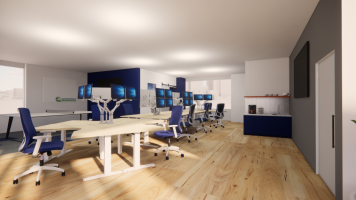benjamin_flight
REGISTERED
I've been wanting to post this question to the group for a long time. I finally took time to draw up the two options to (hopefully) clearly describe my thoughts.
I understand that "Floor Area, Gross" and "Floor Area, Net" are defined in Chapter 2, and that Table 1004.5 Maximum Floor Area Allowances Per Occupant exists to help classify uses of spaces. My question is how to calculate gross areas, as it seems that there could be two ways of doing it.
In Opt 1, I used the term "gross" quite liberally and just made all Business spaces one area. You'll see that the result tallies to 31 occupants total for the tenant space.
In Opt 2, I used the more conservative method of calculating each occupied space individually and the typically-unoccupied spaces as one area. Note that the occupant count jumps to 34 using this method.
I feel that the calculation method of Opt 1 is what the code intends. However, the case could be made that large offices (such as Offices 4, 5, and 6) can easily fit 2+ people (and often do). The tenant space in this example is small, but imagine a floor with dozens of large offices; the occupancy count could jump quite a bit if using Option 2, and might be warranted. However, I don't see that the code intends for gross areas to be partitioned like Option 2.
Am I overthinking this? Is the calculation method of Option 1 the standard and I should just rely on that? Or is the more granular method of Option 2 warranted?
(Side note: please ignore the restroom situation. I'm sure a code-savvy person would catch that I'm not counting the shared restrooms. Still working through that...)
Thanks!
Benjamin
I understand that "Floor Area, Gross" and "Floor Area, Net" are defined in Chapter 2, and that Table 1004.5 Maximum Floor Area Allowances Per Occupant exists to help classify uses of spaces. My question is how to calculate gross areas, as it seems that there could be two ways of doing it.
In Opt 1, I used the term "gross" quite liberally and just made all Business spaces one area. You'll see that the result tallies to 31 occupants total for the tenant space.
In Opt 2, I used the more conservative method of calculating each occupied space individually and the typically-unoccupied spaces as one area. Note that the occupant count jumps to 34 using this method.
I feel that the calculation method of Opt 1 is what the code intends. However, the case could be made that large offices (such as Offices 4, 5, and 6) can easily fit 2+ people (and often do). The tenant space in this example is small, but imagine a floor with dozens of large offices; the occupancy count could jump quite a bit if using Option 2, and might be warranted. However, I don't see that the code intends for gross areas to be partitioned like Option 2.
Am I overthinking this? Is the calculation method of Option 1 the standard and I should just rely on that? Or is the more granular method of Option 2 warranted?
(Side note: please ignore the restroom situation. I'm sure a code-savvy person would catch that I'm not counting the shared restrooms. Still working through that...)
Thanks!
Benjamin

